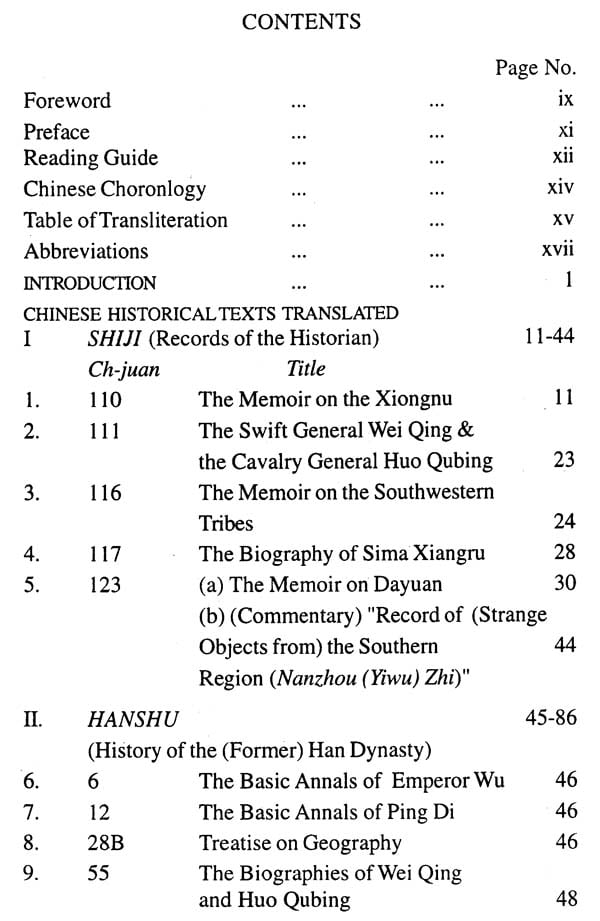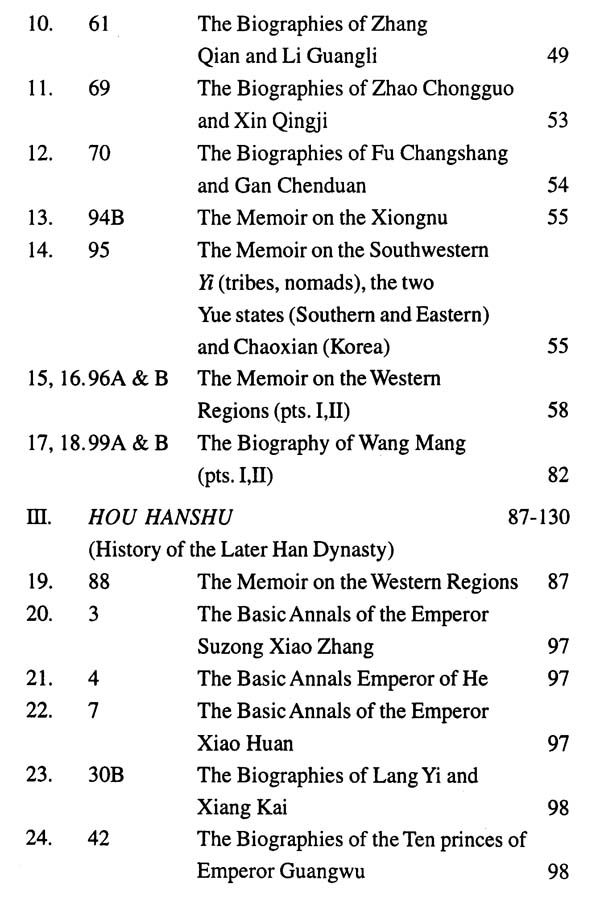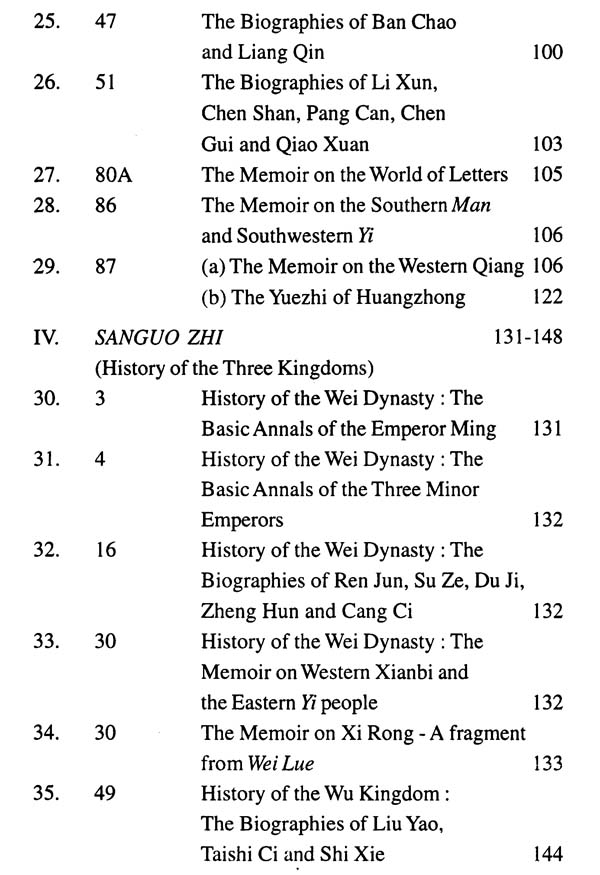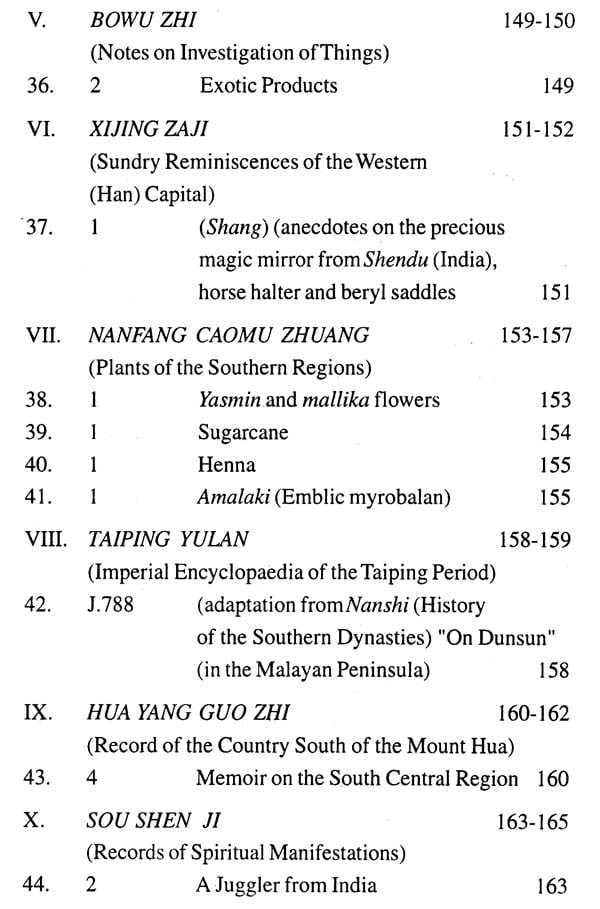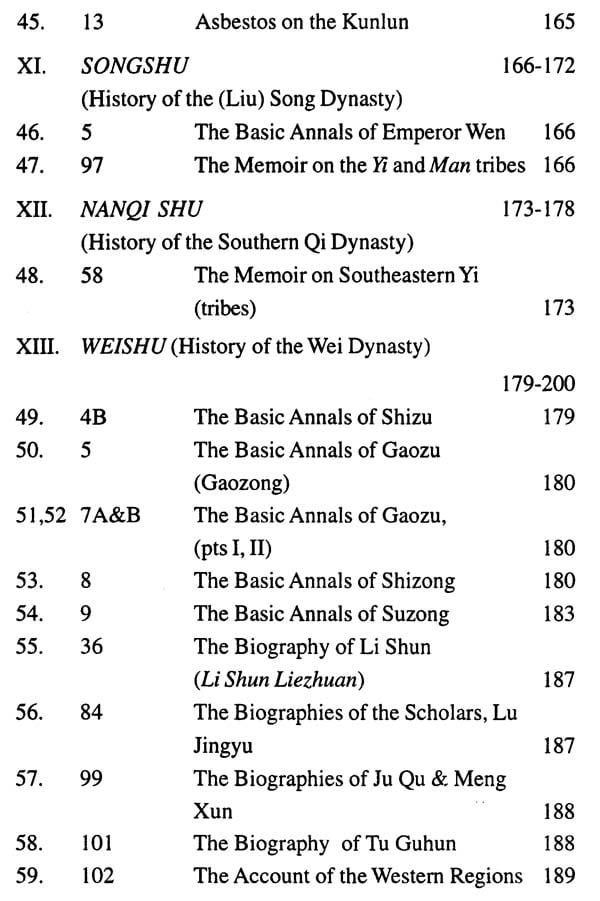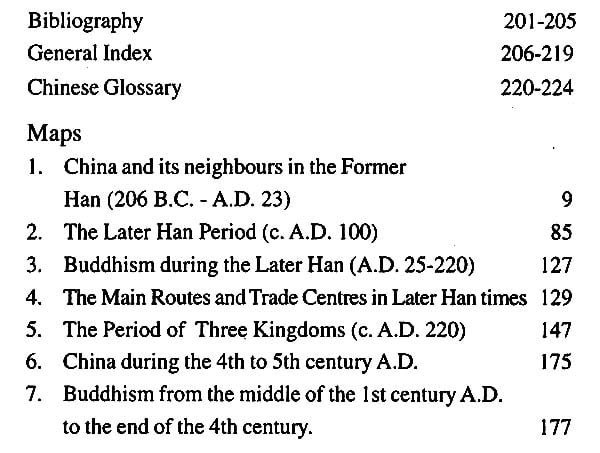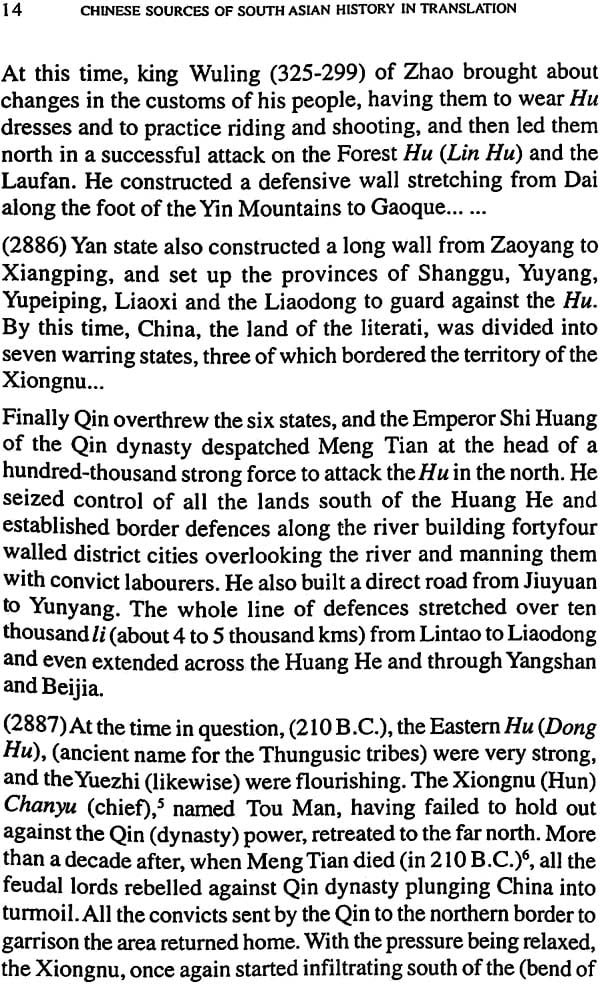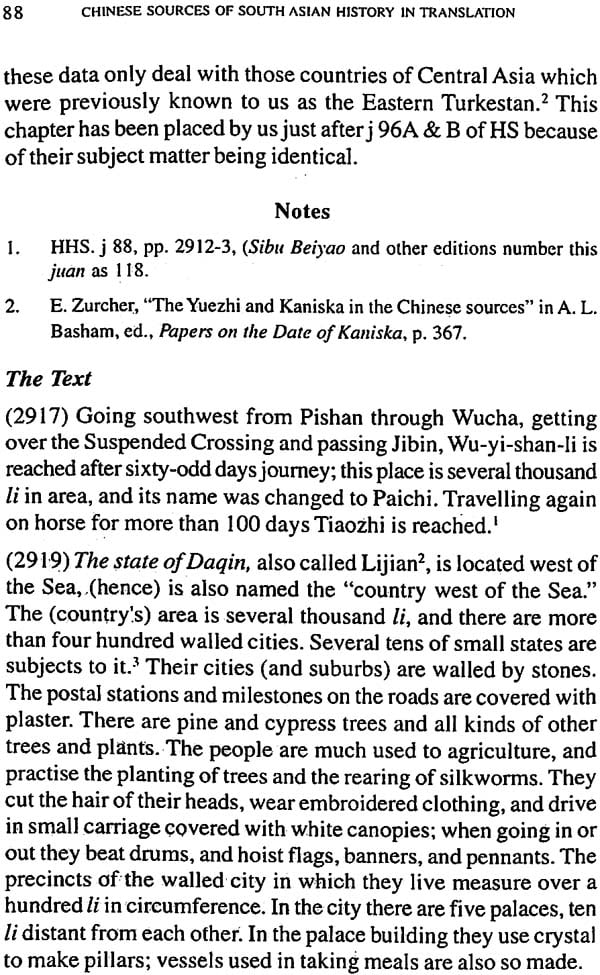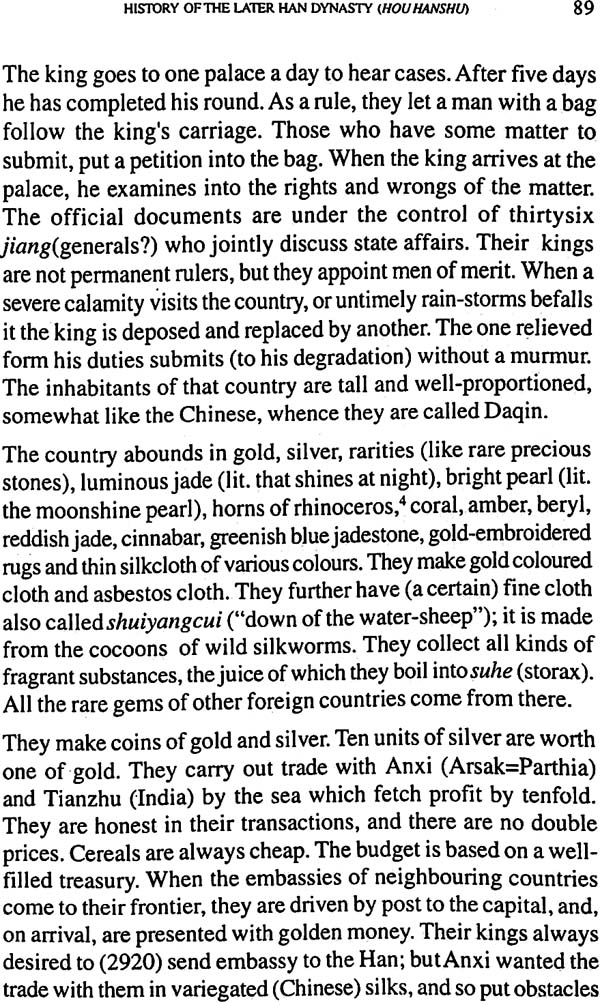
Chinese Sources of South Asian History in Translation- Data for Study of India-China Relations Through History (Vol-I)
Book Specification
| Item Code: | NAV332 |
| Author: | Haraprasad Ray |
| Publisher: | THE ASIATIC SOCIETY |
| Language: | English |
| Edition: | 2004 |
| ISBN: | 8172361513 |
| Pages: | 248 |
| Cover: | HARDCOVER |
| Other Details | 8.50 X 5.50 inch |
| Weight | 380 gm |
Book Description
This is the first volume in the series "Chinese Sources of South Asian History in Translation: Data for Study of India-China Relations through History". It can legitimately be called the first of its kind in the world. The present volume contains the notices, memoirs, biographies, basic annals of Chinese rulers and accounts of different nature from the official and unofficial histories, and records of flora, supernatural anecdotes and sundry matters. The earliest Chinese intercourse with the Southeast Asian states is also available here. A total of 61 entries of varying lengths from 13 important works from Shiji to Weishu have been translated with exhaustive notes and elucidations almost 75 per cent of which are made available for the first time to the scholars of ancient and early medieval South Asian history. The translated texts are evaluated in their proper historical perspective to provide new data and fresh interpretations. Translations are prefixed by notes on the authors and their works as well as introduction to the contents of the treatises from where the texts are lifted.
This and the volumes following it will prove to be essential companions for the scholars of India-China relations and a must read for other cultural historians.
A senior Chinese expert in India, Dr. Haraprasad Ray the author, has already established-his reputation as one of the very few Indian scholars dealing with India-China relations. He has contributed to a number of international seminars in Germany, Hong Kong, China, the U.S.A., London, Paris and other places.
Dr. Ray has already authored some books and more than five dozen articles published in scholarly journals both in India and abroad.
Dr. Ray was Sino-Tibetan Research Scholar in Chinese at Calcutta University during 1953-56. In 1959 he joined the Ministry of Defence as a Chinese language expert and held responsible posts. His service was transferred to the Jawaharlal Nehru University, New Delhi. After retiring from JNU in 1996, he was successively made Senior Fellow of the Society for Indian Ocean Studies and the Indian Council of Historical Research. Presently a Professor at the Asiatic Society, Kolkata, Dr. Ray is now engaged in exploring data on South Asian history from Chinese sources covering the period from the earliest till late 19th century.
This volume as well as the future ones evolve out of my twenty-seven years of teaching Chinese to the undergraduate and post-graduate students at the School of Foreign Languages, Government of India, and the Jawaharlal Nehru University in New Delhi. While its structure was formed by that experience, my intense interest in our great neighbour and the confidence reposed on me by my Indian and Chinese colleagues as well as by the doyen of Indology in China, Professor Ji Xianlin, inspired me to bring the task to pass.
In presenting the first volume of the Chinese Sources of South Asian History in Translation, the present author has not spared any effort to make it as exhaustive as possible within the limitation that a foreign Sinologist is subject to. No one is more conscious than this scribe of his limited knowledge and reading, and the resulting inadequacies in executing this herculean task of translating, annotating and editing historical data comprising information of diverse nature each different from the other. The nature of these Chinese classical texts can best be described in the following words on Banabhatta's structure and style, "very hard outside like a coconut shell, but very juicy and tasteful inside when broken into pieces."
We follow here the periodization adopted by Geng Yinzeng, i.e. the dynasty under which the works were completed; e.g. Liangshu covers the period A.D. 502-556, but was completed in A.D. 629 under the Tang dynasty. Hence it will be included in a later volume comprising the histories of Jin, Chen, Northern, Qi, Sui and Tang.
The Fuoguo Ji of Faxian (also known as Faxian Zhuan) and Da Tang Xiyu Ji of Xuanzang have been left out because translation (with critical notes) of these works by James Legge, S. Beal, Li Yunghsi and T. Watters (summarised version of Xuanzang's work) are already available in India. However, we may take up the relevant chapters of these works for critical study at a later date, as has already been done in the case of Xuanzang's travelogue in two articles.
Reading Guide
1. Guo has been translated in several ways, namely, 'country', 'kingdom' or 'state'; 'state' has been used in a general way and not in the modern political sense.
2. Short introductions on the authors have been provided with introductory notes to the chapters and sections translated.
3. Portions not translated have been indicated by three dots, and, wherever necessary, summaries of texts have been provided as links between two parts; these summaries have been placed under double brackets at both ends.
4. In the Contents, the names of works come first, followed by their translations in brackets; e.g. I. Shiji (Records of the Historian); while in the case of the translated texts, the arrangement has been reversed; e.g. I. Records of the Historian (Shiji). The Contents also give detailed list of titles with their juan numbers.
5. The Chapters (Juan) or parts thereof translated are given after the abbreviated forms of the works; e.g. SJ. 110, HHS. 88. etc. followed by the English translation of the titles with the Chinese originals in brackets.
6. The pages of the original Chinese texts in their Zhonghua Shuju editions, unless otherwise stated, are given in brackets, and to avoid confusion, prefixed by 'p' in the beginning of each work.
7. A Brief Chinese Chronology from the earliest up to the last dynasty covered in this volume, has been provided. 8. The Chinese texts give the traditional lunar dates of imperial reign periods, etc.; their corresponding Gregorian calendar dates are given in the translated texts in brackets; distance, identity of geographical names, weights, measures, etc. are also given in their modern forms in the texts. Those requiring explanation have been given in the end notes.
9. The Chinese lunar months, lst month, 2nd month and so on, normally begin one month or so later than the Gregorian; i.e. 1st month will generally coincide with the last week of January or first week of February. Readers may refer to the Chronology given at the end of Cihai, Ciyuan, or consult A Sino-Western Calendar for Two Thousand Years, 1-2000 A.D., Commercial Press, Hong Kong, 1961, for details.
10. The Pinyin system of transliteration has been used for Chinese geographical terms and proper names. For those not familiar with this system, a comparative table of Pinyin and Wade-Giles system has been given along with Nagari and Bangla equivalents for the convenience of Indian scholars.
11. Seven maps have been attached to give the readers a concrete idea about China's territory and its historical expansion, as well as extent of dissemination of Buddhism from early first century to 5th century A.D. Some of the names on the maps are in Wade-Giles system of transliteration adopted in most of the historical texts.
Preamble
In course of my teaching and research extending over more than four decades, I had often foundered for want of readily available source material from Chinese records which are massive, voluminous and overwhelming in dimension. While looking for original texts, I had to first scrounge for the texts all over the world and then set myself to translating them all on my own. This was an extremely excruciating and time-consuming ordeal. In this process, I had initially done translation of some medieval documents in connection with my doctoral dissertation on fifteenth century Bengal.
The demand for embarking on such an enterprise became irresistible. My students, research scholars, young historians in India, and friends from China encouraged me. But the problem of locating the Chinese records scattered all over China remained the only snag. This problem was eventually solved by the publication of an exhaustive compilation by Prof. (Ms) Geng Yinzeng of Peking University in 1994. But heavy teaching assignments at the University and my preoccupation with fifteenth century India-China trade and diplomacy (both Northern and Southern India) forced me to keep the project pending till my retirement. Award of fellowship by both the Indian Council of Historical Research and the Asiatic Society, Calcutta(Kolkata), in succession gave me the fillip to initiate this ambitious project.
Aims
The main purpose of this massive project is to translate the materials on South Asian history from Chinese historical writings for the benefit of the scholars of ancient and medieval history. For this purpose, I made a beginning with the Records of the Historian (Shiji) which is the earliest historical treatise available till date. This work was completed around 90 B.C. by the first and foremost imperial historian, Sima Qian (145-90 B.C.). He laid down the principle and pattern of writing dynastic history.
Such a highly stylised work written in old Classical Chinese, has to be approached with great care. It covers a wide gamut of events starting from the hoary past to about 99 B.C. (Former Han Dynasty), and encompasses China and the neighbouring countries. The work includes geographical names (now defunct), locations and historical personalities, and many other bewildering varieties of data. The decipherment, elucidation and clarification of all such points need a lot of time, labour and cross references to determine their exact meanings. This is time-consuming and cumbersome. Despite these limitations, I have made considerable progress in translating data from this magnum opus as well as the works succeeding it, namely, Hanshu, Hou Hanshu etc.
According to my original plan, I started translating texts included in the Collection of South Asian Historical Materials from Chinese Sources (Zhongguo Zaijizhong Nanya Shiliao Huibian), edited by Prof. Geng Yinzeng of Peking University (1994). But, in course of my translation, I discovered that the editor has, at times, left out long passages from the original works, when inclusion of some of them, passages and even chapters, would have been of use to the study of ancient Indian history, as well as of India's contacts with her neighbours. Therefore, I decided to apply my own judgement, and started including detailed accounts wherever necessary. The accounts on the Xiongnu (Hun), the Yuezhi (Kushana) and the Qiang are some of them. This exercise consumed substantial labour and time, delaying the progress in translation work.
The Story
Some of the salient features of the materials translated may be summed up as under :
A.The Hun and the Kushana
The Northwest Indian and Central Asian panorama is extremely colourful and eventful. In this vast spectrum, the Xiongnu (Hun) and the Yuezhi or Da Yuezhi (Kushana) have played both constructive and destructive roles.
The fear of the Hun compelled the different states of China to build the Great Wall of China, but when the Wall failed to prevent the Hun invasions, the Chinese were forced to organise huge cavalry forces to contain them. The Chinese campaigns against the Hun brought the Chinese to the fringe of Northwest India, namely, Bactria, Ferghana, and other countries. The Hun were instrumental in hybridization of the Chinese race through marriage, mutual surrender and other means. They also forced the Yuezhi to migrate from the west of China to Northwest India, a branch of which was known here as the Kushana (Guishuang in Chinese), the people who are known for their contribution to the social and cultural life of India.
In course of my research, I got so many data on the Xiongnu and the Yuezhi that I felt it imperative to go into the origin of the words, Xiongnu and Yuezhi. Xiongnu is wrongly rendered into English as Hun. An intensive search has been made, and a tentative conclusion has been arrived at. It transpires that at some stage, the Chinese employed them as serfs and used the name Xiongnu in the sense of "brave serfs" (The Hun used to be strong and intrepid in comparison with the Han).
The title of the Xiongnu chief was Chanyu (also pronounced Shanyu). We accept Bailey's derivation of the word from the Old Iranian Xsavan meaning "king" : Xsavan was presumably corrupted into Chanyu or Shanyu through overlapping or transposition of the sound of the last part of the word (note 5 to the translated text of Shiji, j.1 10).
Similarly, the word Yuezhi which has baffled the scholars for a long time, is supposed to be connected with the word Kusha, which means "moon" in Tokharian language. The Chinese word Yuezhi meaning "the Moon clan" is a direct translation of the Tokharian. Later, the name was probably also pronounced Yuedi or Yaedi (Yaeti) due to historical reasons when the tribe moved into Bactria.
B. Evolution of Chinese Foreign Policy on the Highlands and the Steppe of Central Asia
The intra-regional and intra-ethnical relations delineated in Shiji and Hanshu demonstrate how the Chinese diplomacy developed through alliance, intimidation, war and, above all, by dint of the policy of 'loose-rein' (jimi) and 'kind treatment' (huairou) to win the hearts and allegiance of these nomadic people called the 'uncivilised foreigners' (shufan). It shows how the Chinese emperors had to change their conciliatory attitude to belligerence due to the perennial scourge of the Hun.
Other tribes who stood in awe of the Hun and were keenly aware of the Hun hostility against the Han (Chinese), did not cooperate with the latter in selling their excellent horses for fear of Hun retaliation. When the Chinese subdued the Hun and completely subjugated the Wusun (an ally of the Hun), the situation. turned for the better in favour of the Chinese court and the supply of the Central Asian "heavenly horses" continued uninterruptedly. All these ups and downs are described minutely by the historian, Sima Qian, who was a witness to most of the campaigns against the unruly nomads. His and others related accounts have been translated by me in detail for the benefit of the scholars.
C. The Kushanas in Chinese History
The chequered history of the Kushana in Central Asia and India is known mainly from Chinese sources; these are supplemented by Greek and other foreign accounts, as well as the coins and other relics available to us. The accounts of Kushana influence in the Central Asia and its friendship as well as encounter with Han China are given in the History of the Later Han Dynasty (Hou Hanshu) and other later dynastic histories from where the related chapters have been translated by me.
D. Introduction of Buddhism into China-the Earliest Date
Historians have so long believed that Buddhism was introduced into China during the later part of 1st century A.D. But clear evidences are now available about a Chinese scholar-official named Jinglu having received lessons in Buddhism from a Kushana (Da Yuezhi) prince or official in 2 B.C. The story has been repeated in later histories also, giving it a stamp of authority. We have collected and translated them.
**Contents and Sample Pages**
